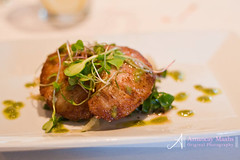 Image by amanky via Flickr
Image by amanky via FlickrIf you love fresh, wild-caught seafood prepared in imaginative ways, a Manhattan restaurant called Esca will make you feel right at home. This week and next, three-course lunches cost only $24.07 -- about the price of an entree the rest of the time -- as part of the Restaurant Week promotion, but tables are difficult to reserve.
I was by myself Friday, and when I called to reserve the day before, I was offered a table in the bar area or outdoors, on what was to be a sweltering day. I took the table near the bar. During Winter Restaurant Week, no table was available at Esca, which is partially owned by Chef Mario Batali and was one of the first non-Japanese restaurants to serve raw fish or crudo.
Three appetizers, three entrees and a single dessert are offered for $24.07. I chose halibut cheeks for my appetizer and local yellow-fin tuna for an entree. The final course was panna cotta (cooked cream) with fruit, nuts and honey.
To me, this is something of a game. I try to avoid extra charges, leave a 15% tip and round off the bill -- with tip and tax -- to $30. That means tap water during the meal and declining the flight of wines for an extra $10 or so. No coffee at the end, either. After more than a decade of these bargain lunches at some of the city's best restaurants, maybe it's time to loosen up.
When these meals were first offered in the late 1990s, they were priced to mimic the year: $19.97, $19.98 and so forth. In the early 2000s, however, the price jumped inexplicably from $20-something to $24-something, so the old format is no longer being followed.
I loved the food and service at Esca, though I could do without the French tourists sitting next to me, a young man and two women who seemed disinclined to speak to their neighbor. I wanted to ask them whether Paris had a Restaurant Week.
The halibut cheeks were bigger than I expected -- about 1 by 2 inches. They were nicely fried, served on a bed of fragrant, baby arugula and topped with a few thin onion rings. When they were brought to me, I had already eaten a half-dozen olives and a small piece of toast topped with white beans, compliments of the chef, plus two pieces of wonderful bread. I kept on asking for bread during the meal -- one was crusty with a doughy center, the other a thick, whole-wheat focaccia.
I expected a small, yellow-fin tuna steak for the entree, but was bowled over by two medallions -- an inch to an inch and a half thick -- with grill marks outside and cooked medium rare inside, as requested. A cold, heirloom squash salad topped with some pesto was served with the fish, which was tender and delicious and needed only a squeeze of fresh lemon juice. I sopped up the juices and pesto with bread.
I usually don't eat dessert, so the panna cotta was a treat, and reminded me of Spanish flan without caramel. Service was excellent, with crumbs from all the bread I ate cleared away between courses.
On the way to the rest room, I nearly bumped into a man, and the waiter said, "Watch out for the fish monger." Feeling full and contented with this cool meal on a hot day, I walked briskly the couple of blocks to the Port Authority Bus Terminal for the trip home.

Damn this blog is making me hungry. I should know better than to read it before breakfast. You might point out that Halibut cheeks are indeed cheeks. The great outdoors writer Jerry Kenney of the Daily News once pointed out to me that although fishermen often toss the head of the bluefish, popular in local waters, the smart ones would carve out the cheeks before disposing of the head, as they were indeed a delicacy. Which, of course, begs the question, does a halibut even have a butt?
ReplyDeleteI've always been a fan of fish cheeks, but my wife claims the head when we order a whole fish out, which is frequently. The halibut that gave up these cheeks must have been a pretty big fish, because, unlike humans with big butts, the cheeks don't grow independently. Maybe if the fish holds its breath and puffs out its cheeks.......
ReplyDelete